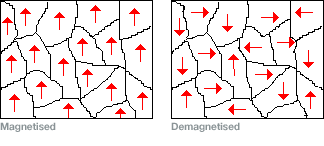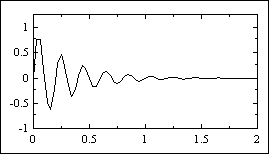Materials capable of holding magnetisation (if looked at on a very small scale), can be considered to be many separate domains each acting as a tiny magnet. When a material is magnetised these “tiny magnets” are all aligned in the same direction.
To demagnetise an item the objective is to totally randomise these “tiny magnets” so they all point in different directions.

The randomisation is achieved by applying a magnetic field, of a sufficient strength, that switches these domains between north and south. The magnitude of the applied field is reduced to zero resulting in a demagnetised item.

The “tiny magnets” will at first try to align themselves with the applied magnetic field and as it changes polarity they will also try to rotate. As the magnitude of the field decreases a point will occur when an individual “tiny magnet” will get “stuck” and will no longer follow the applied field. Each individual “tiny magnet” will get stuck at a different magnetic field strength. The overall effect will, therefore, be to produce a lower overall magnetic field from the material.
To generate a demagnetising field a large current is passed through a coil. The unit capable of generating the required voltage and current is referred to as the demagnetiser. The current generated by the demagnetiser is fed into a demagnetising fixture or demagnetising coil. A demagnetising fixture is a special coil of wire that has been optimally designed to achieve the desired demagnetisation field when coupled with the appropriate demagnetiser.
While the above description is not technically correct in detail, for all magnetic materials, it is a useful model that is able to explain demagnetising behaviour.
